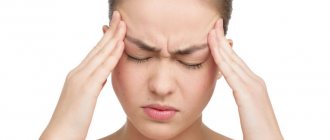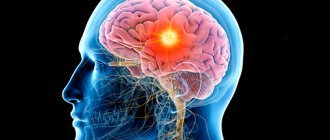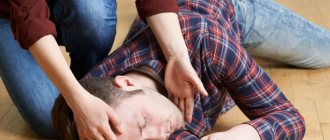Restless legs syndrome, what is it? Symptoms and treatment
Willis disease is a common neurological disease nowadays, popularly called restless legs syndrome. Expressed as discomfort in the legs. Because of this condition, you want to constantly move your legs, itching, burning, and “goosebumps” appear on the skin. The pathology is unpleasant - after a hard day at work it is impossible to sleep or lie down in a calm state.
The syndrome occurs most often in people over 40 years of age, but young people are also affected. The disease occurs more often in women than in men. This is explained by the fact that men have a stronger nervous system. The causes of the disease vary.
What it is?
Restless legs syndrome (RLS) is a condition characterized by unpleasant sensations in the lower extremities that appear at rest (usually in the evening and at night), force the patient to make movements that relieve them and often lead to sleep disturbances.
Current population studies indicate that the prevalence of RLS is 2–10%. RLS occurs in all age groups, but is more common in middle and old age. RLS is the cause of approximately 15% of cases of chronic insomnia - insomnia.
Causes
These include:
- Genetic diseases.
- Brain or spinal cord injuries.
- Misuse of antidepressants , antipsychotics , calcium blockers, as well as medications for nausea, seizures and allergies.
- Deficiency of vitamins, micro- and macroelements in the body. In particular, lack of vitamins B1, B9, B12, calcium, magnesium.
- Pregnancy. Some of the vitamins and minerals in the body of the expectant mother are spent on the formation of the fetus. This can lead to a lack of calcium and magnesium, which can lead to leg twitching at night. In pregnant women, the syndrome is more often observed in the second half of the term.
- Kidney failure. When the disease occurs, the electrolyte balance is disrupted, which contributes to the appearance of muscle cramps and restless legs syndrome.
- Stress.
- Ultra-intense physical activity.
- Diabetes.
- Anemia. Iron deficiency negatively affects the development of pathology.
- Cryoglobulinemia. Accompanied by a complex of symptoms - vasculitis (inflammation of blood vessels), enlarged liver, spleen, joint pain, etc.
- Multiple sclerosis – damage to the brain or spinal cord
- Rheumatoid arthritis is inflammation of small joints throughout the body.
- Hyperthyroidism or hypothyroidism is a dysfunction of the thyroid gland.
- Alcoholism or drug addiction.
- Radiculitis.
- Amyloidosis is a disorder of protein metabolism, which is accompanied by heaviness in the stomach, heart failure, edema and kidney problems.
- Varicose veins and thrombophlebitis.
- Chronic obstructive pulmonary disease (COPD).
- Parkinson's disease.
- Tourette's syndrome.
- Caffeine abuse. Taking coffee or caffeine tablets in large quantities (more than 0.4 g of caffeine) can trigger symptoms of the disorder.
Causes
Primary syndrome is poorly studied and affects young people under 30 years of age. Not associated with major diseases, it accounts for up to 50%. Accompanies a person throughout his life, alternating periods of progression and remission. Occurs suddenly, the reasons are not clear, it may be:
- heredity in 20-70% of cases;
- disturbances in the functioning of the central nervous system;
- psychological circumstances (stress, depression, fatigue).
Secondary syndrome - manifests itself against the background of a primary (neurological or somatic) disease, disappears after their elimination. Frequently encountered:
- disruption of blood supply;
- kidney diseases, arthritis;
- vitamin deficiency (group B) and magnesium deficiency;
- anemia due to iron deficiency;
- diabetes mellitus, thyroid diseases;
- abuse of alcohol, tobacco, caffeine;
- treatment with certain medications.
Secondary syndrome occurs after 40 years of age or later. The exception is pregnancy. More than 16% of pregnant women suffer from this disease, 3 times more than non-pregnant women. There is a possibility of genetic transmission of RLS from mother to fetus, which poses a threat to pregnancy.
Pathogenesis
The effectiveness of dopaminergic drugs and the possibility of worsening symptoms under the influence of antipsychotics indicate that a key element in the pathogenesis of RLS is a defect in dopaminergic systems. The clear daily rhythm of clinical manifestations of RLS may reflect the involvement of hypothalamic structures, in particular the suprachiasmatic nucleus, which regulates the daily cycles of physiological processes in the body.
It is possible that in some patients with RLS, polyneuropathy, iron deficiency, coffee abuse or other factors only reveal an existing hereditary predisposition, which partly blurs the line between idiopathic and symptomatic variants of RLS.
Medical information
Willis-Ekbom disease , the second name for restless legs syndrome, often has a genetic predisposition. Having a close relative with the disease increases the risk of a movement disorder.
Scientists believe that the pathology is associated with a disruption in the production of dopamine , the hormone of anticipation of pleasure. Symptoms of the disease appear in the evening or at night. Therefore, the syndrome is presumably associated with improper functioning of the hypothalamus . The hypothalamus is the part of the brain that is responsible for the circadian sleep-wake rhythm. The syndrome, by the way, can develop without structural lesions of the hypothalamus.
According to ICD-10 (International Classification of Diseases, 10th revision), restless legs syndrome has code G25.8 - Other specified extrapyramidal and movement disorders.
The disorder can be idiopathic or symptomatic . The first option means that the disease is primary, that is, it is the main one and is not caused by other pathologies. In the second option, the syndrome is a consequence or symptom of another disease.
Symptoms of RLS
The symptom is characterized by the occurrence of unpleasant sensations of a piercing, scraping, itching, pressing or bursting nature in the lower extremities. The manifestation of symptoms mainly occurs at rest; with physical activity they are significantly reduced.
To alleviate the condition, patients resort to various manipulations - stretching and bending, massaging, shaking and rubbing their limbs; during sleep they often toss and turn, get out of bed and walk from side to side, or shift from foot to foot. This activity helps stop the symptoms of restless legs syndrome, but as soon as the patient goes back to sleep, or simply stops, they return. A characteristic feature of the syndrome is the manifestation of symptoms at the same time, on average it reaches its maximum severity in the period from 12 am to 4 am, the minimum occurs from 6 to 10 am.
In advanced cases, with prolonged absence of treatment, the daily rhythm of restless legs syndrome disappears, symptoms appear at any time, even while sitting. This situation significantly complicates the patient’s life - it is difficult for him to withstand long trips in transport, work at the computer, attend cinemas, theaters, etc.
Due to the need to constantly move during sleep, over time, the patient begins to experience insomnia, which leads to rapid fatigue and drowsiness during the daytime.
Symptoms
Restless legs syndrome is distinguished by characteristic clinical features - sensory and motor. They are usually bilateral, less often asymmetrical. There are no unpleasant symptoms of the disease in the morning until noon. Towards evening, the patients' condition worsens. An exacerbation of the syndrome is observed from midnight to dawn. In severe cases, symptoms occur around the clock, not only while lying down, but also while sitting. Persons with the syndrome cannot stay in transport for a long time, work at a computer, or go to the movies.
localization of RLS lesions
- Patients experience burning, itching, trembling, bursting, squeezing and cutting pain in the legs. They claim to feel muscles moving and twitching. The intensity of the discomfort varies and reaches acute pain during an attack. For some, trembling in the thighs is quickly replaced by tingling in the feet, for others, the entire limb “cramps” from pain. The location of pain is usually the legs and feet. The inconsistent and wave-like nature of discomfort is characteristic of RLS. Attacks occur at night, immediately upon falling asleep. Any movement of the legs helps relieve pain. When the patient falls asleep, the pain returns with renewed vigor.
- Paresthesia and other sensory disturbances are also basic to this disease. Patients complain of a feeling of numbness, pressure, goosebumps crawling on the skin, a feeling as if “someone is scratching.” These symptoms burden patients and cause them discomfort. Paresthesia usually occurs on the legs, feet, and as the disease progresses, they cover the thighs, arms, and perineum. When patients' entire torso becomes numb, the sensations become simply unbearable. Sensory disturbances appear half an hour after a person goes to rest. It is possible that they appear earlier and even appear during the day. Paresthesia, like pain, disappears when moving the legs, walking, or self-massage. The condition is alleviated by increasing the activity of blood flow.
- Involuntary leg movements during sleep last on average 5 – 40 seconds. As the pathology progresses, neuropathic rhythmic movements persist throughout the night. Patients bend and straighten their fingers, spread them apart, and rotate their feet. Seriously ill patients bend their knees. Motor episodes occur repeatedly at night and awaken patients.
- Insomnia is the result of unpleasant sensations in the legs at night. Patients sleep restlessly, waking up every 2-3 hours, or do not sleep at all. Over time, chronic insomia develops, manifested by weakness after sleep. Patients' ability to work is reduced, concentration is impaired, and fatigue occurs. They become irritable, emotionally unstable, and quick-tempered. Many people become depressed or neurasthenic.
All symptoms of RLS are subjective. In patients with the idiopathic form of the pathology, there are no disturbances in the neurological status: they do not exhibit focal and general cerebral symptoms, pathological reflexes and other changes. In the secondary form, which is a manifestation of a neurological disease, characteristic disorders of the nervous system appear, which allow a preliminary diagnosis to be made.
CNS control of movement coordination
The syndrome rarely occurs in children. It also manifests itself as pain in the legs. The cause of the pathology is a mental disorder caused by a lack of proper attention from parents to the child. Daytime hyperactivity is another cause of the syndrome. Modern medical scientists cannot determine exactly how and why the disease develops, but they argue that the problem cannot be solved without treatment.
Diagnostics
Basic diagnostic methods:
- Blood test for iron, magnesium and folic acid levels. Helps to determine the deficiency of the listed elements, which may be provoking factors of pathology.
- Electroneuromyography is a method of studying nerves and muscles using special equipment. In this case, sensitive sensors are attached to different parts of the body and diagnose the degree of electrical excitability of a particular muscle group.
- Polymonography is a comprehensive approach that allows you to diagnose motor activity during sleep. Special sensors record awakenings and muscle activity. Unlike electroneuromyography, the person is in a sleeping state.
Drug treatment
In cases of mild disease, only these measures may be sufficient, and the disease will recede. If they do not help, and the disease causes persistent disruption of sleep and vital functions, then they resort to medications.
Medicines used for illness:
- Dopaminergic drugs (preparations containing L-DOPA - Nakom, Madopar, Sinemet; dopamine receptor agonists - Pramipexole Pronoran, Bromocriptine). These are the first-line drugs of choice; treatment begins with them. For medications containing L-DOPA, the initial dosage is 50 mg levodopa 1-2 hours before bedtime. If this is not enough, then after about a week the dose is increased by another 50 mg. The maximum dose is 200 mg. Dopamine receptor agonists have an effect comparable in effect to L-DOPA drugs. Pramipexole is prescribed starting from 0.125 mg, the dosage can be increased to 1 mg, Bromocriptine - from 1.25 mg (up to 7.5 mg), Pronoran - from 50 mg (up to 150 mg). If one dopamine receptor agonist is ineffective, it is advisable to replace it with another.
- Benzodiazepines. Among this chemical group, Clonazepam (from 0.5 mg at night and up to 2 mg) and Alprazolam (from 0.25 mg to 0.5 mg at night) are most often used. Benzodiazepines have a greater effect on sleep than on discomfort and periodic movements in the legs, so they are considered “backup” drugs for the treatment of restless legs syndrome.
- Anticonvulsants (Gabapentin, Neurontin, Carbamazepine) and opioid drugs (Tramadol, Codeine, Dihydrocodeine, Oxycodone). These drugs are used as a last resort only if dopaminergic and benzodiazepine drugs are ineffective or produce significant side effects. Gabapentin is prescribed in increasing dosages, starting with 300 mg and reaching a maximum dose of 2700 mg (stopping at the dose that has an effect). The entire dose is taken at night in one dose. Tramadol is taken 50-400 mg at night, Codeine - 15-60 mg, Dihydrocodeine - 60-120 mg, Oxycodone - 2.5-20 mg. These narcotic drugs are used only in particularly severe cases of restless leg syndrome because they can be addictive.
Willis disease is insidious in that patients often require long-term medication, so the doctor tries to select the minimum dosage of medications to relieve symptoms and have a gentle toxic effect on the body.
It is especially difficult to treat pregnant women. In such cases, the specialist tries to identify and eliminate the cause of the disease. In most cases, the culprit is a lack of microelements, especially iron. This condition is normalized after a course of iron-containing medications. If more serious disorders are detected in the body, doctors advise eliminating the symptoms of restless leg syndrome in pregnant women using non-drug methods, and small doses of drugs (usually Clonazepam or Levodopa) are prescribed for a short time and only in extreme cases.
Additional techniques
As a complement to drug therapy and proper lifestyle in the treatment of Ekbom syndrome, physiotherapeutic procedures are used, which include:
- Vibromassage.
- Reflexology is a method in which special needles are inserted into specific points on the body.
- Magnetotherapy is the use of magnetic fields that have anti-inflammatory, analgesic and decongestant effects.
- Darsonvalization of the legs - using a special device, a high-frequency, rapidly decaying current is applied to a certain part of the body.
- Lymphopress is the creation of pressure on the lymphatic system in order to normalize metabolic processes in the body and increase the tone of the veins of the lower extremities.
- Mud applications are a method using therapeutic mud. When used, blood circulation improves, the movement of red blood cells improves, and metabolism is normalized.
Folk remedies for the fight against RLS
To alleviate the condition of restless legs, a lot of traditional medicine tips have been described that can be used together with complex treatment:
- Bay oil. Add 30 g of bay leaf to 100 ml of olive oil and let the liquid brew in a dark place for about 2 weeks. With the resulting tincture, you should massage your feet every evening before bed.
- Soothing tea. This drink will help improve sleep, calm and relax your muscles. You will need a mixture of valerian roots, oregano and mint herbs. Additionally, you need to wash 10 rose hips. You can use both dried and fresh versions. Next, you need to place rose hips and 1 tsp in the kettle. mixtures of herbs. Then pour 400 ml of boiling water over everything and let stand for at least 40 minutes. You need to take this tea 2 hours before bedtime for a month, 1 glass.
- Horseradish tincture. Pour crushed roots and leaves of horseradish with alcohol or vodka and leave for 4–5 days in a dark place. Rub your feet regularly with this product.
- Healing bath. It is necessary to prepare a decoction of wormwood, rosemary and linden. All herbs need to be mixed and 3 tbsp. l. pour 1 liter of boiling water. Cook for 15 minutes. Then judge, filter and add the liquid to the foot bath. For 3 liters of water you need 1 liter of decoction. The temperature must be at least 38 degrees. Exposure time 15 minutes. Such baths should be done every other day for a month.
- Golden mustache tincture. Rub the lower limbs with pharmaceutical tincture before going to bed.
- Hawthorn infusion. Brew 1 tbsp. l. hawthorn berries with a glass of boiling water and drink the drink shortly before bed. This will calm the nervous system and help relieve discomfort in the legs.
You should not self-medicate, especially if you are not sure of your diagnosis! Consult a doctor who can confirm or refute your suspicions of restless legs syndrome, and also recommend how to cope with the pain.
Treatment for restless legs syndrome
Let us repeat that there is no universal cure for restless legs syndrome. Treatment is determined by the presence of specific factors for the development of restless legs syndrome. Here are the most common methods of treating this disorder: drug treatment, physiotherapy, balneotherapy, exercise therapy. and occupational therapy, psychotherapy, diet therapy. Treatment of restless legs syndrome can be carried out by doctors of different specialties: therapists, neurologists, psychotherapists or others, depending on the true causes of the development of the syndrome.
Brain Clinic provides full diagnostics and treatment of restless legs syndrome according to individually developed schemes.
If the usual treatment of restless legs syndrome does not help or is ineffective, we use special techniques of restorative medicine based on the principles of complex therapy, developed by the chief physician Vladimir Anatolyevich Kozlovsky and improved by the collective work of the clinic’s doctors.
Development of restless legs syndrome
- Genetic theory suggests a hereditary mechanism for the transmission of restless legs syndrome. In such cases, treating restless legs syndrome would be very difficult. In practice, this condition is quite well treated.
- The neurotransmitter theory suggests that symptoms develop as a result of a disturbance in the exchange of neurotransmitters in the nervous system, which leads to overexcitation of the motor centers of the brain. In this case, the use of specific drugs that we use in the concept of restorative medicine in the treatment of restless legs syndrome gives good dynamics and high efficiency.
- The theory of organic damage to the central nervous system explains the development of restless legs syndrome by the presence of structural damage in the nervous tissue, in this case restless legs syndrome is a classic neurological microsymptom. Neurometabolic and physiotherapeutic treatment of restless legs syndrome, carried out in the clinic when organic disorders are identified, shows high effectiveness.
It is relatively not difficult to discern the condition of restless legs in a patient.
Treatment at home
At home, you can completely follow all the measures that will reduce the symptoms of the disease to a minimum.
- It is imperative to create your own sleep schedule - fall asleep and wake up at the same time. If a patient suffers from neuropsychiatric disorders, the doctor will definitely advise training the mind.
- Physical exercise. Moderate physical activity has a positive effect on the condition of the legs. During the day and before bed, it is useful to do exercise therapy, walk, do Pilates, swimming, yoga or stretching. But too active sports can provoke an increase in symptoms, so running, jumping, football and volleyball are contraindicated for people suffering from Willis disease.
- Contrasting douches. Take contrasting foot baths, alternating cold and hot water.
- Hobbies. At home you can find something to do: drawing, knitting, reading. Concentration helps relieve stress.
- Systematic foot massage. Rubbing the lower extremities before bed can reduce discomfort and make it easier to fall asleep.
You can take cream or resort to the folk remedies that we indicated earlier. Be sure to avoid caffeine-containing products. Eat iron-containing foods and sleep in cotton socks. Some sources talk about the benefits of wearing sheep wool socks. Don't overeat at night. Having received a boost of energy, it will be more difficult for the body to fall asleep.
Treatment process
Treatment of RLS is complex, including drug therapy, the help of a psychotherapist, physiotherapy, and the use of traditional medicine. If all measures are applied together, it is possible to return a sick person to normal life in a relatively short time.
Treatment of secondary syndrome is etiotropic, aimed at eliminating the causative disease. For patients with endocrinopathies, hormones are prescribed, for anemia - multivitamins, for poisoning - detoxification therapy.
Treatment of the idiopathic form of the syndrome is carried out according to the standard regimen. Mild cases of pathology are treated with sedative herbal remedies - valerian extract, motherwort tincture. All other forms require full-fledged drug therapy.
- Sleeping pills - Clonazepam, Phenazepam, Alprazolam.
- Dopaminergic agents – “Sinemet”, “Permax”, “Mirapex”.
- Anticonvulsants - Gabpentin, Carbamazepine, Neurontin.
- Opioid medications - Plazadol, Tramolin, Codeine, Oxycodone.
- Vitamin and mineral complexes.
Specialists also prescribe local remedies for patients in the form of ointments, gels and creams - “Nurofen”, “Dolgit”, “Ketonal”.
Physiotherapeutic methods that complement drug therapy for RLS:
- Magnetotherapy,
- Mud treatment
- Vibromassage,
- Cryotherapy,
- Acupuncture,
- Endodermal electrical stimulation,
- Manual therapy,
- Lymphopressotherapy,
- Darsonvalization.
Psychotherapy is another therapeutic technique, which is a consultation with a psychotherapist who will identify and eliminate the patient’s mental disorders.
Patients can relieve their condition on their own at home.
- During an attack, you can walk around the room and do light leg exercises. The main thing is to move at this time, and not lie or sit.
- During the day, it is useful for such patients to change their position more often. Persons who are forced to sit for long periods of time at work should periodically change the position of their legs.
- Self-massage of your feet before bed and rubbing them will slightly reduce the intensity of pain and help you fall asleep.
- Experts recommend normalizing your work and rest schedule, not overeating at night, fighting bad habits, and enriching your diet with foods high in iron and vitamins.
- You should go to sleep and wake up at approximately the same time, sleep on a comfortable bed in a ventilated and clean bedroom.
- Patients' physical activity should include exercise therapy, walking before bed, Pilates, swimming, and yoga.
- Patients will benefit from contrast showers, douches and foot baths.
- At home, it is better to concentrate on your favorite hobby - drawing, knitting, reading, which will help relieve excessive stress.
- Individuals with RLS may benefit from wearing socks made from natural wool.
By following these simple rules, some patients with a mild form of the disease, even without medication, noted an improvement in their general condition.
The most effective and common folk remedies used to eliminate the symptoms of the disease include:
Bay oil or olive oil for foot massage,- Horseradish tincture and apple cider vinegar for rubbing,
- Decoctions of medicinal herbs for taking foot baths in the evenings,
- Mint, linden and chamomile tea for oral administration,
- A decoction of rosemary and wormwood for a healing bath before bed,
- Hawthorn infusion for use at night,
- Lavender essential oil for aroma lamp,
- Cold lotions and compresses to relieve tension and trembling in the legs,
- Alcohol tincture of red hot pepper for rubbing sore and tired feet.
Restless legs syndrome is one of the pathologies that take a long time and hard to treat. Doctors start with low dosages of drugs, gradually increasing them if necessary. This is due to the toxic effect of some drugs on the human body.
Prevention
There is no consensus among patients on how to get rid of unpleasant attacks in the legs at night. Each patient has his own methods and means. We can only note that to reduce night attacks it is useful to carry out preventive measures:
- Cancel late dinner, do not go to bed on a full stomach;
- Yoga or Pilates classes;
- Swimming;
- In the autumn and spring, taking vitamins;
- Change your working position frequently, take breaks with small gymnastic exercises;
- Walk outside before bed;
- Wear only cotton clothes, no synthetic materials. Feet should always be warm.
In general, there is no specific prevention for the hereditary form of restless legs syndrome. The main preventive measures are aimed at treating primary diseases, which over time can lead to the development of polyneuropathy and disruption of the dopaminergic system.











